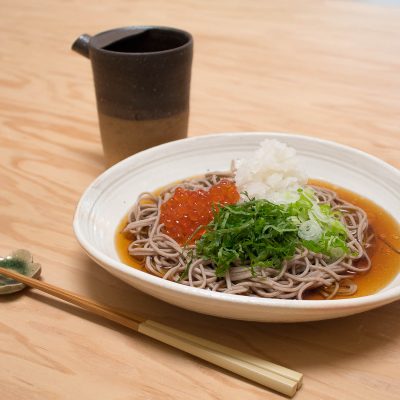Tag Archives: Soba
Cold Somen Noodle with Soy Dipping Sauce
Perfect for a hot summer day. Here’s one of my most basic cold noodle dishes which I never get tired of all my life. Donabe can make a perfect serving vessel, and it also makes a wonderful presentation, along with a variety of toppings.
For the dipping sauce, I have this staple soy-based sauce, Kaeshi, always in handy. Kaeshi is a multi-purpose sauce I use for so many things. I pour over noodle by mixing with water/ dashi, chicken, fish, salad, etc.
Soba Noodle with Green Onion and Shiitake Mushroom
Soba noodle is one of the most beloved traditional Japanese foods in Japan. Many people enjoy soba dishes for lunch, and there are soba restaurants (many are hand-made) and stands everywhere in Japan. At home, soba makes a very popular meal. This is my quick soba noodle dish I love and make all the time for lunch, and I change the toppings according to what I have in my fridge or pantry. Sometimes, I serve with just mushrooms, wakame seaweed, or even completely plain with a dash of yuzu citrus zest. With the porous body of the donabe, I like that the broth stays hot until the end of the meal.
Shiso Chicken Meatball & Grated Daikon Hot Pot
This dish is packed with nutrients, and so easy to make. It’s also a great dish to enjoy with guests. Chicken meatballs have the very nice subtle shiso flavor and they become fluffy after cooked. I like adding a generous amount of coarsely grated daikon (I highly recommend you use Onioroshi daikon grater for the nice crunchy texture for grating daikon). They give both texture and more flavor to the dish.
For seasoning, I use both white tamari and soy sauce for more complex flavor (and also to keep the broth from becoming too dark), but you can use just soy sauce if you like. You can also adjust the seasoning with extra sea salt at the end. But, please remember, this dish is served with Sansho Ponzu Sauce, so the seasoning should be minimum.
Make sure to save enough broth, so you can enjoy the shime (finishing course) of soba noodles!
Soba Noodle with Hot Mushroom Dipping Broth
I love making this dish especially when I am feeling a little weak and need something gentle for my stomach. Once you simmer mushrooms in a rich dashi-based broth, pour it into serving bowls and dip cold noodles in it to enjoy. The mushrooms adds the nice savory flavors to the broth. And, I love to use a generous amount of thinly-sliced ginger for both flavor and helping my body stay warm after having the dish. It’s so soothing and you can keep eating more and more. This dish is also nice to serve for a larger group. You can also change around the ingredients to cook in the broth for fun. For a vegan version, you can make with kombu dashi or vegetable dashi instead of kombu & bonito dashi.
Cold Soba with Black Vinegar Dipping Sauce
Zaru Soba (cold soba with dipping sauce) has been a traditional fast food since Edo Period (1,603 – 1868) in Japan. From kids to elders, people in any social class can enjoy the fresh and smooth soba by quickly dipping in a sauce. While it’s a very popular quick dish for lunch, you can also find soba restaurants or posh izakaya establishments that serve soba as a final course after various small dishes to savor. I remember my late father ate soba for lunch 3 – 4 times a week because it was on of his very favorite foods. This version, instead of a typical soy sauce and mirin based sauce, I made it with an extra amount of dashi with a generous addition of brown rice black vinegar. The result is a very refreshing umami-packed dipping sauce, which you can even drink up (and it’s so good for you because of its high vinegar content).
Cold Soba with Salmon Roe and Grated Daikon
This is another quick cold noodle recipe with toppings that don’t require any cooking. Ikura (salmon roe) and grated daikon are a classic combination in Japanese cuisine and they work great with the cold soba. When daikon is grated in a traditional onioroshi (bamboo daikon grater), as opposed to generic metal or plastic grater, the daikon retains a nice crunchy texture while retaining its moisture well. Besides, using onioroshi is kind of like a ritual to me. It’s fun and almost therapeutic to grate daikon with a onioroshi. Don’t forget to add a good amount of thinly-sliced shiso leaves, as it gives a beautiful aroma along with sliced green onions (but if you don’t have shiso, it will still work without it).













